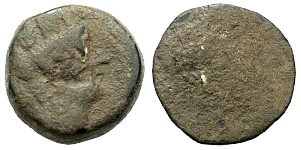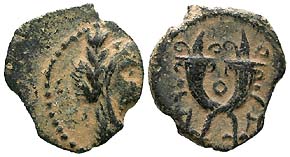Fine Coins Showcase
Antiquities Showcase
Hide empty categories
Shop Search
Shopping Cart
My FORVM
Contact Us
About Forum
Shopping at Forum
Our Guarantee
Payment Options
Shipping Options & Fees
Privacy & Security
Forum Staff
Selling Your Coins
Identifying Your Coin
FAQs
zoom.asp
Home ▸ Catalog ▸ |Judean & Biblical Coins| ▸ |Biblical Coins| ▸ |Christmas||View Options:   | | | | | | "After Jesus was born in Bethlehem in Judea, during the time of King Herod, Magi from the east came to Jerusalem and asked, 'Where is the one who has been born king of the Jews? We saw his star in the east and have come to worship him" Matthew 2:1-8. |


Christ birth year coin? Many biblical scholars believe Jesus was actually born in 4 B.C. or perhaps even a year or two earlier.GB17275. Bronze AE 21, RPC I 4392, SGCV I 5879, Lindgren 2063, Fair, weight 6.721 g, maximum diameter 19.9 mm, Laodikeia mint, year 44, 5 - 4 B.C.; obverse veiled and turreted head of Tyche right, oval countermark (head right); reverse IOYΛIEΩN / TΩN KAI behind, ΛAOΔIKEΩN and date ΔM before, Tyche standing left, rudder in left hand, cornucopia in right; SOLD
Nabataean Kingdom, Aretas IV, 9 B.C. - 40 A.D.


Aretas IV was the greatest Nabataean king, ruling S. Palestine, most of Trans-Jordan, N. Arabia, and Damascus. He took the name Philopatris, lover of his people. Aretas married Shuqailat, his second wife, in 16 A.D. Aretas' daughter Phasaelis was married to, and divorced from, Herod Antipas. Herod then married his stepbrother's wife, Herodias. It was opposition to this marriage that led to the beheading of John the Baptist. After he received news of the divorce, Aretas invaded the territory of Herod Antipas and defeated his army. Paul mentions Aretas in connection with his visit to Damascus, when he had to sneak out of the city in a basket lowered from a window in the wall to escape (2 Corinthians 11:32). Al-Khazneh, one of the most elaborate buildings in Petra, is believed to have been his mausoleum.GB02039. Bronze AE 14, Al-Qatanani 149; Barkay CN 150i; Meshorer Nabataean 73A; Huth 78; BMC Arabia p. 10, 34; Schmitt-Korte II 44; Lindgren 2522, VF, obverse 1/3 off-center, profile off flan, irregular ragged flan, weight 1.140 g, maximum diameter 14.2 mm, die axis 0o, Petra (Jordan) mint, 8/7 B.C. - 15/16 A.D.; obverse laureate head of Aretas right; reverse two crossed cornucopias, Nabataean letter O (ayin) between the horns, Nabataean H (het) lower left and right; SOLD
The Temple Tax Coin, Tyre KP Type Half Shekel, Jerusalem or Tyre Mint, 33 - 34 A.D.


POSSIBLE CRUCIFIXION YEAR COIN. The Bible does not tell the date of the Crucifixion, but based on Biblical clues, the Jewish calendar and astronomical evidence many scholars believe it was Friday, April 3, 33 A.D. John the Baptist began his ministry in 28 or 29 A.D. and the Gospel of John points to three separate Passovers during Jesus' ministry. Jesus was executed on the orders of Pontius Pilate, the Roman prefect of Judaea from 26 to 36 A.D. This limits the years to between 30 and 36 A.D. John P. Meier's, A Marginal Jew, cites 7 April 30 A.D., 3 April 33 A.D., and 30 March 36 A.D. as astronomically possible Friday Nisan 14 dates during this period. Isaac Newton, using the crescent of the moon, determined the year was 34 A.D. but John Pratt argued that Newton made a minor computation error and 33 A.D. was the accurate answer using Newton's method. Using similar computations, in 1990 astronomer Bradley Schaefer arrived at Friday, April 3, 33 A.D. A third method, using a completely different astronomical approach (consistent with Apostle Peter's reference to a "moon of blood" in Acts 2:20) based on a lunar Crucifixion darkness and eclipse model arrives at the same date, Friday, April 3, 33 A.D.JD40425. Silver half shekel, RPC I 4693, Prieur 1463, BMC Phoenicia -; only one coin from this year in the hoard, aF, weight 6.249 g, maximum diameter 20.4 mm, die axis 0o, Tyre or Jerusalem mint, 33 - 34 A.D.; obverse laureate head of Melqart right, lion's skin knotted around neck; reverse TYPOY IEPAΣ KAI AΣYΛOY (of Tyre the holy and inviolable), eagle standing left, head left, wings closed, right talon on war galley ram, palm frond transverse right behind, PNΘ (year 159) over club left, KP over BA(?) (control) right, Aramaic aleph (control) between legs; very rare year; SOLD
Kingdom of Persis, Ardaxsir (Artaxerxes) II, 1st Century B.C.


Persis was located in what is now southern Iran. "Persians" settled the area as early as the 8th century B.C. From the time after its conquest by Alexander the Great, Persis was most often quasi-independent, under the hegemony of a Seleukid or Parthian king. Immediately following Alexander's death, Persis was subject to the Seleucid Kingdom. About 290 B.C., Persis regained independence. The coins produced during this period were Greek-inspired, but inscriptions were Aramaic, symbolic of Persis' rejection of the Greek ruling class. Sometime between c. 250 and 223 B.C., the Seleucids regained control. Mithradates II later incorporated Persis as a sub-kingdom of Parthia. Under Parthian domination, the coins and appearance of the kings depicted on them assumed the Parthian style. The last King of Persis, Artaxerxes, defeated the Parthians and founded the Sassanian Empire.SH06330. Silver drachm, Alram IP 570; Klose-MŁseler 4/10b; Sunrise 598; BMC Arabia p. 222, 2; Tyler-Smith -, aEF/VF, nicely toned, reverse off center, light earthen deposits on reverse, edge cracks, edge ragged, weight 3.82 g, maximum diameter 23.6 mm, die axis 325o, Persepolis (Fars Province, Iran) mint, 1st Century B.C.; obverse bust left, short pointed beard, wearing Persepolitan crown with turrets and diadem, torque and cloak, monogram behind; reverse Aramaic inscription: Araxsir, king, son [of] Darev, king, king on right, standing left before fire altar, raising scepter in left hand; SOLD
Indo-Scythian Kingdom, Azes II, c. 35 - 5 B.C.


Azes II may have been the last Indo-Scythian king in the northern Indian subcontinent (modern day Pakistan). Indo-Scythian rule crumbled under the conquests of the Kushans who expanded into India to create the Kushan Empire. Senior and Hoover now believe Azes II did not exist and attribute all Azes coins to Azes I or as posthumous imitative issues. A type attributed to Azes I has been found overstruck on a coin traditionally attributed to Azes II, supporting their hypothesis.WA57599. Silver tetradrachm, Senior 98.329T; Mitchiner IGIS 6, 8489i; FrŲhlich 274; Mitchiner ACW 2368 var. (obv control letter), HGC 12 637, gVF, weight 8.974 g, maximum diameter 23.2 mm, die axis 45o, obverse BAΣIΛEΩΣ BAΣIΛEΩN MEΓAΛOY AZOY, king on horseback riding right, holding whip, Kharosthi letter ti (control letter) before horse; reverse Kharosthi legend: Maharajasa rajadirajasa mahatasa Ayasa (of great king, king of kings, Azes the Great), Pallas standing right, raising right hand, spear over left shoulder and shield on left arm, monograms in left and right fields, Kharosthi letter va upper right; SOLD
Roman Syria, Antioch, Civic Series, 11 - 12 A.D., The "Star of Bethlehem Coin"


Michael Molnar, an astronomer, believes this coin depicts Jupiter's occultation of Aries in 6 B.C., the most probable "Star of Bethlehem."RY83419. Bronze AE 21, RPC I 4266; BMC Galatia p. 159, 62; Butcher 56, VF, weight 7.711 g, maximum diameter 21.2 mm, die axis 0o, Antioch (Antakya, Turkey) mint, 11 - 12 A.D.; obverse Zeus' laureate head right; reverse ANTIOXEΩN MHTPOΠOΛEΩN, ram running right, looking back, star above, BM (year 42) below, ANT monogram in exergue; SOLD

You are viewing a SOLD items page.
Click here to return to the page with AVAILABLE items.
The sale price for a sold item is the private information of the buyer and will not be provided.



Page created in 1.094 seconds.






